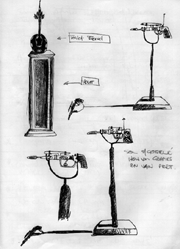 |
 |
 |
 |
 |
 |
 |
 |
 |
 |
 |
 |



Figure 83: Johann van der Schijff. Back to the Future, 1993.
[ Return to: Part 1 - 3.Artistic Feedback; 3.4.Video Art ]
The fictional ergonomics of this work is such that the rock, carved to fit into a human hand, becomes a spacecraft once it is thrown at the enemy. A surveillance antenna, similar to the one turning on the plane, and a micro-chip embedded in stone, are the guiding devices linking the piece to the conceptual cybernetic system of the other work. This archetypal handweapon is suspended in space by an old fuel line protruding out of the base of the sculpture. [Figure 83]
Figure 84: Eduardo Paolozzi. Japanese War God, 1958.
(Read 1987: 235)
Back to the Future reflects on how human intelligence has led to the invention of increasingly efficient machines for wholesale suicide. The work draws formally on sculptures made by Paolozzi and Brancussi. Paolozzi's bronze sculptures such as Head and Japanese War God [Figure 84] combine found objects to form new relationships between each other, thereby creating archetypes. The base refers, not only visually to the zig-zag motive found in Brancussi's sculpture, but also to his approach of merging the base to become part of the sculpture. [Figure 85]
Figure 85: Constantin Brancusi. Adam and Eve, 1921.
(Shanes 1989: 61)
Figure 86: Johann van der Schijff. Back to the Future, 1993.
Mild-steel; copper; stainless steel;
sandstone; computer components.
H: 2030 mm W: 590 mm L: 600 mm


Figure 88: Johann van der Schijff. Drawing no. 2,
Back to the Future, 1993.
Figure 89: Johann van der Schijff. Drawing no. 3,
Back to the Future, 1993.
Figure 90: Johann van der Schijff. Drawing no. 4,
Back to the Future, 1993.
Figure 91: Johann van der Schijff. Drawing no. 5,
Back to the Future, 1993.
 |
 |
 |
 |
 |
 |